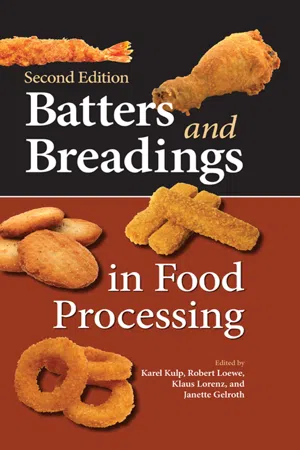
- English
- ePUB (mobile friendly)
- Available on iOS & Android
Batters and Breadings in Food Processing
About This Book
For the first major update of this topic in 21 years, editors Kulp, Loewe, Lorenz, and Gelroth have gathered an elite group of internationally recognized experts. This new edition examines the current market trends and applications for coated food products. It updates our knowledge of ingredient utilization in battered and breaded products using corn, wheat, rice, fats and oils, and flavorings and seasonings. It applies the functionality of these ingredients across the rheology of coating systems and into the selection of specific processing equipment
Each chapter explores a different facet of developing batter-based coatings and breadings for a variety of new products, and explains how new technology has turned this profitable food category into a science. New authors have contributed chapters on heat and mass transfer in foods during deep-fat frying, nutritional aspects of coated foods, and food allergens.
Batters and Breadings in Food Processing, Second Edition presents essential technical and scientific information in a peer-reviewed resource. It will be valuable reference for food technologists in Research and Development, Quality Assurance, Rheology, and Bakiing. It will make an excellent text for any course with a batters and breadings processing component.
Frequently asked questions
Information
Batters and Breadings—Past, Present, and Future Markets
Definition of the Coated-Foods Market
Past Trends for Coated Foods
Present Marketing of Coated Foods
| 1950s | The Present | |||
| Retail | Food Service | Retail | Food Service | Evolutionary Trends |
| Purchase, take home, prepare, eat | Purchase, eat on premises | Purchase, take home, prepare, eat Purchase, eat on premises Purchase, take out or deliver, eat at home | Purchase, eat on premises Purchase, take out or deliver, eat at home | Purchase of fully prepared meals (ethnic-, caloric-, or nutrient-specified), take out or deliver, eat at home Purchase of meals formulated to address a specific medical or dietary need, take out or deliver, eat at home Purchase of foodstuffs or meals through outside procurement services, take out or deliver, eat at home Purchase in bulk (at “clubstores”), take out or deliver, eat at home |
Table of contents
- Cover image
- Title page
- Table of Contents
- Copyright
- Contributors
- Preface to the Second Edition
- Preface to the First Edition
- Chapter 1: Batters and Breadings—Past, Present, and Future Markets
- Chapter 2: Ingredient Selection for Batter and Breading Systems
- Chapter 3: Dry-Milled Corn Ingredients in Food Coatings
- Chapter 4: Frying Fats for Coated Foods
- Chapter 5: Effective Use of Flavorings and Seasonings in Batter and Breading Systems
- Chapter 6: Factors Affecting Performance Characteristics of Flours in Batters
- Chapter 7: Functionality of Hydrocolloids in Batter Coating Systems
- Chapter 8: Food Allergens: Issues and Concerns in Batter and Breading Applications
- Chapter 9: Nutrition Information Related to Battered and Breaded Food Products
- Chapter 10: Breadings—What They Are and How They Are Used
- Chapter 11: Heat and Mass Transfer in Foods During Deep-Fat Frying
- Chapter 12: Technology of Microwavable Coated Foods
- Chapter 13: Batter and Breading Process Equipment
- Chapter 14: Application of Batters and Breadings to Various Substrates
- Chapter 15: Measurement and Interpretation of Batter Rheological Properties
- Chapter 16: Food Coating Troubleshooting
- Chapter 17: Food Coating Patent Review, 1990–2007
- Index
